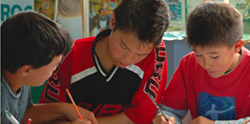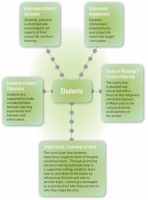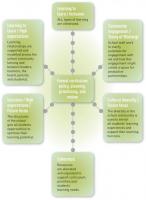Curriculum decision making using the principles
In The New Zealand Curriculum, the preamble to the principles states that they should 'underpin all school decision making' (page 9).
Before they can be put into action in a local context, the principles need to be interpreted.They are written in a way that gives schools considerable power in making decisions about the taught curriculum and school structures and processes.
One challenge is to decide whether to approach the principles individually or as an interconnected set.
The diagrams and school examples in this Update provide a guide to putting the principles into action through exploring the potentially fruitful connections between and among them.
Thinking about the principles
When you are discussing the principles or basing curriculum decisions upon them, you need to think in a wide rather than narrow way with the needs of your learners in mind.
Current ways of thinking about knowledge emphasise uncertainty, connectedness (through networks and flows of people and information), and the emergent (exploratory or evolving) nature of learning.
The principles can be a steady reference point as you navigate the complexities of curriculum decision making. Using the principles can help you to organise and focus activity while allowing diversity to be expressed. The principles provide a common framework for action that accommodates multiple possibilities.
Putting students at the centre
These principles put students at the centre of teaching and learning, asserting that they should experience a curriculum that engages and challenges them, is forward-looking and inclusive, and affirms New Zealand’s unique identity.
The New Zealand Curriculum, page 9
Putting students at the centre does not mean that decisions about the curriculum are handed over to them. But it should mean that students are involved in curriculum decision making, and participate in or help to lead actions, in a partnership led by the professionals. Being actively involved in their education helps students to take responsibility for their learning and to grow as independent and resourceful individuals.
This diagram sets out some ideas about how you can use the principles to guide decisions that put students at the heart of curriculum, without abdicating professional wisdom. The combinations of principles in the diagram are illustrative; many others are also possible.
If you cannot view or read this diagram, select this link to open a text version.
The Treaty of Waitangi principle in the New Zealand Curriculum.
This curriculum principle is embedded in each of the other principles, highlighting the place of Māori as tangata whenua and the bicultural foundations of Aotearoa New Zealand. In the New Zealand Curriculum, the potential of Māori students should be a major consideration for curriculum decision making.
The three examples below illustrate how the other curriculum principles might interact with the Treaty of Waitangi principle in the classroom. They encourage thinking about how including te reo Māori me ōna tikanga and working with whānau, hapu, and iwi can benefit learners.
Three examples of the curriculum principles in action
Example 1
Hunter, P. and Farthing, B. (2008). 'Students Think History and Teachers Learn'. Set: Research Information for Teachers, no. 1, pp. 15–22.
This article illustrates how a history teacher provided opportunities for students to use their life experiences in their thinking about some big ideas in history. One Māori student chose to draw a picture to demonstrate their understanding of change as an important concept in history. In the context of the task and associated conversations, this student was able to bring their own cultural perspectives to bear on the topic. The teacher was able to use insights from this and similar activities to shape learning conversations about the nature of history as a subject. Along with the Treaty of Waitangi, the principles that are potentially involved include cultural diversity, inclusion, community engagement, and coherence.
Example 2
Otrel-Cass, K., Cowie, B., and Glynn, T. (2009). 'Connecting New Zealand Teachers of Science with Their Māori students: Linking the School’s Pou Tuata with Forest Ecology'. Set: Research Information for Teachers, no. 2, pp. 35–41.
This example illustrates how a primary teacher helped her students to make links between their own life experiences, Māori culture, and big ideas in science. The teacher built on her students’ interest in a pou (carved marker pole) recently erected in the school grounds, using it as a stimulus during a unit on forest ecology and an associated science trip to a local forest to view an ancient half-carved canoe. Kaumātua provided guidance and support. To conclude the unit, the students shared at school assembly what they had learned. The principles potentially involved include Treaty of Waitangi, community engagement, and learning to learn.
Example 3
Harris, F. (2009). “Reading Related Language Abilities: Māori Children ‘at Promise’”. Set: Research Information for Teachers, no. 3, pp. 11–18.
This example illustrates the insights that can emerge when teachers and researchers expose, then set aside, their own cultural assumptions and assess evidence of students’ learning in ways that take account of the cultural contexts of the students’ lives. The author demonstrates how traditional tests of oral proficiency, based on Western cultural assumptions, can portray children who are bilingual in English and te reo as deficient in foundation reading skills. Viewed through a different test lens – one that takes account of differences in oral traditions – the pre- and early-reading skills are progressing as expected. In addition to the Treaty of Waitangi principle, the principles that are potentially involved include high expectations, future focus, and learning to learn.
Questions for reflection
- What sorts of curriculum decisions are illustrated in these examples?
- We are all culturally located, that is, shaped by our history, culture, and social settings. How might this understanding help you to work in culturally responsive ways?
- How does knowledge of your own cultures (personal, subject, school) provide an important foundation when working in culturally inclusive ways?
- Does the teacher's role change when the Treaty of Waitangi principle is put at the heart of curriculum decision making?
- What are some of the important features of the teaching and learning relationships in these school examples?
Embedding the curriculum principles in the school's culture
The principles don’t apply only to classroom decision making. They underpin the way the school culture allows for all students to learn and supports students to see themselves as learners.
The principles feed into formal curriculum policy, planning, prioritising, and review – that is, all the operational processes that bring the curriculum to life within a school.
This diagram illustrates some possibilities.
If you cannot view or read this diagram, select this link to open a text version.
Questions for reflection
How might the principles inform decisions about our:
- timetable
- school-wide curriculum planning
- students' agency and involvement
- academic and social support and guidance for our students
- reporting processes
- appraisal processes
- resource selection and allocation
- professional learning policies and plans
- board professional learning
- relationships with the community?
Other articles for discussion
MacFarlane, S. (2009). “Te Pikinga ki Runga: Raising Possibilities”. Set: Research Information for Teachers, no. 2, pp. 42–50 (specifically discusses implications of the Treaty of Waitangi for school decision making).
Bishop, R. and Berryman, M. (2009). “The Te Kotahitanga Effective Teaching Profile”. Set: Research Information for Teachers, no. 2, pp. 27–33 (describes six characteristics of ways effective teachers interact with students).
Published on: 26 Mar 2010
Return to top




